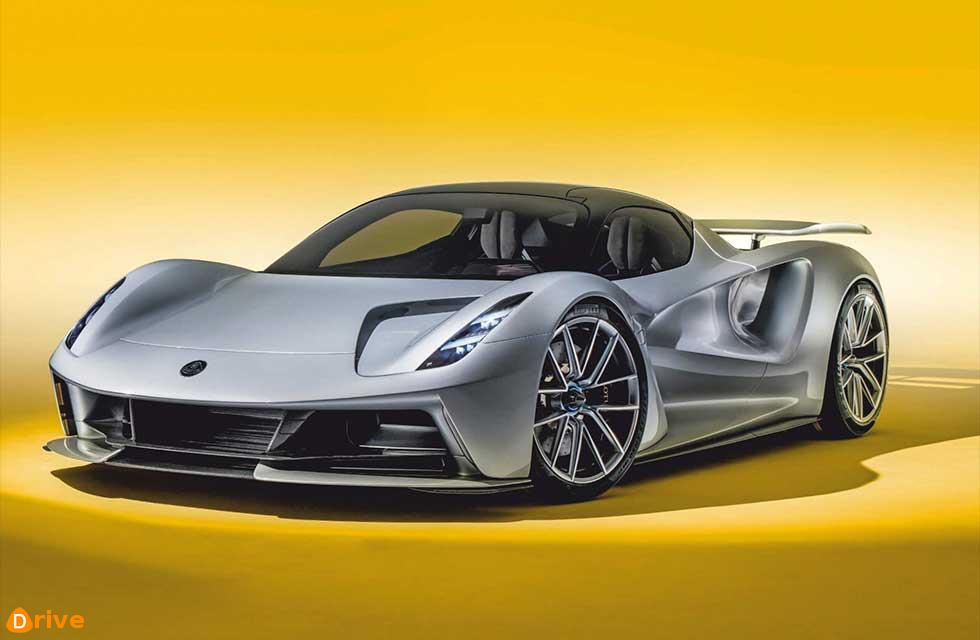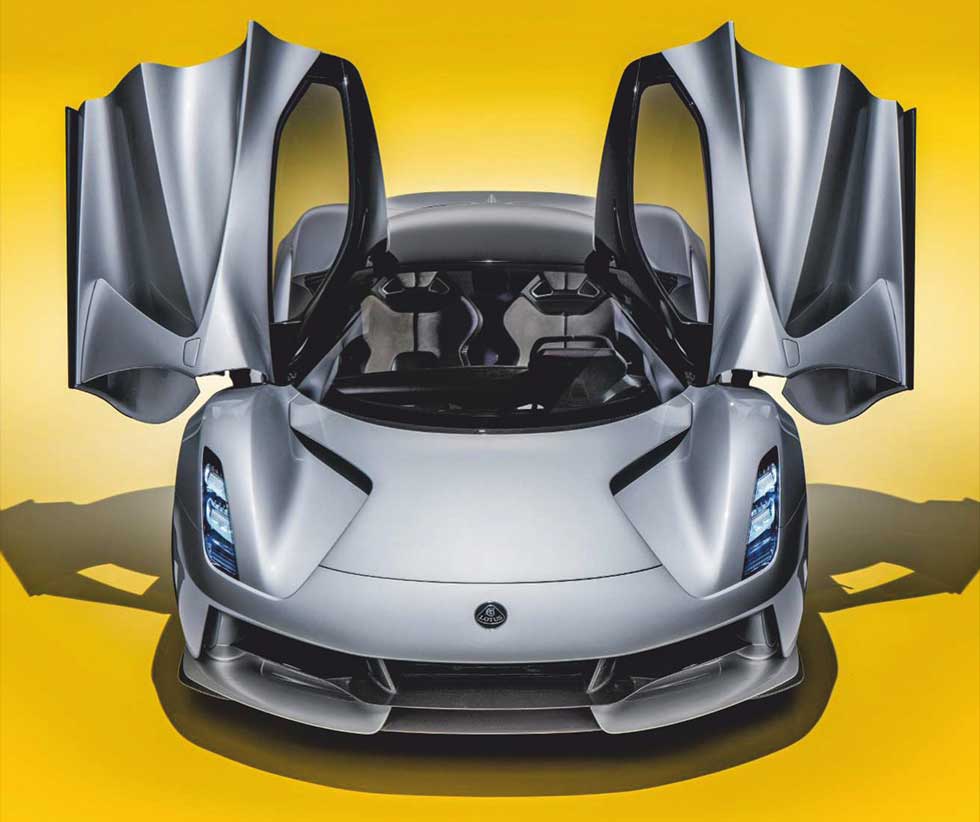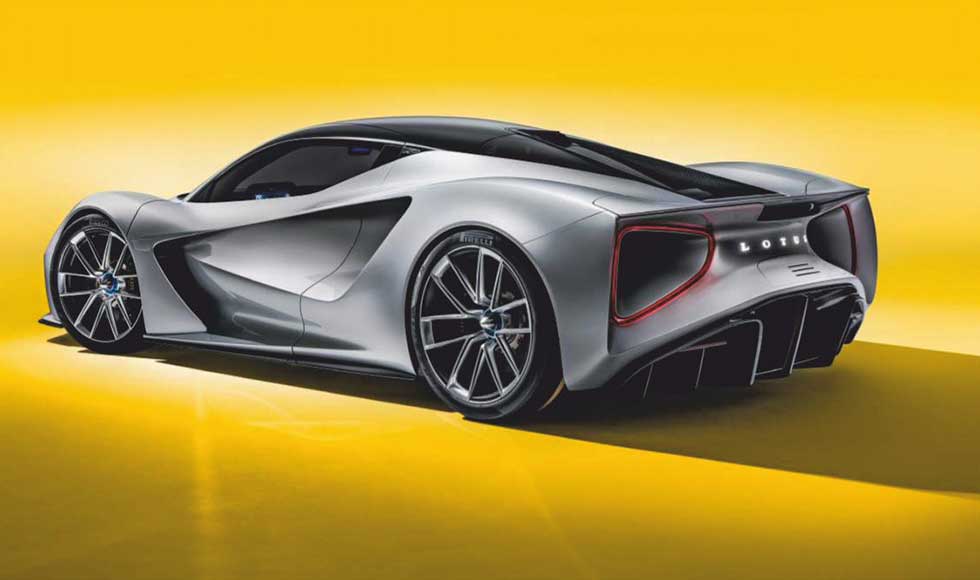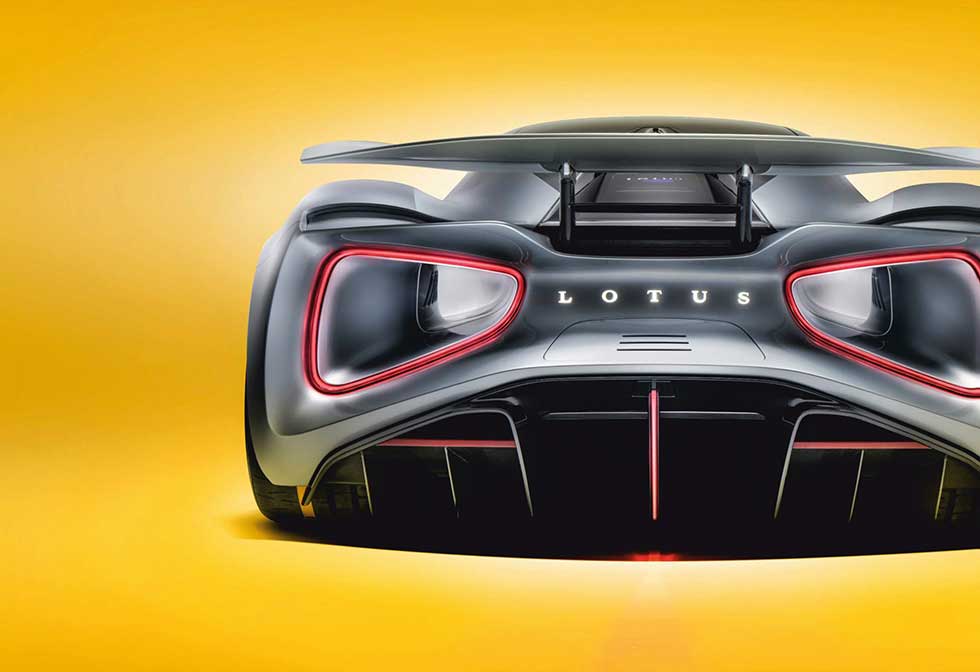Once More with funding New owners, new funding, new rules. If we weren’t sure of the scale of Lotus’s ambition in the Geely era, the astonishing electric Evija is emphatic: huge. Words Gavin Green. Photography John Wycherley.
Lotus shock!
BACK FROM THE BRINK WITH A NEW ELECTRIC SUPERCAR
All-electric Evija slingshots Lotus into the future
Lotus is the fallen hero of British sports car makers. No other company has a finer heritage – six F1 world drivers’ titles no less – or a more noble bloodline of great old sports cars, from Elan to Elite, from Esprit to Elise.

Yet Lotus today sells fewer than 2000 cars a year globally, is habitually unprofitable and has launched no all-new car for 11 years. Former rivals Porsche and Ferrari no more consider the Hethel company a serious competitor than Man City worry about the form of Accrington Stanley.
Tightly surfaced and muscular, it is an overtly aero design with vast ducts and a diffuser like a Le Mans racer
That’s all about to change. Buoyed by new Chinese ownership and emboldened by massive new investment, Lotus is set to return to the sports car premier league. The first sign of this long-awaited renaissance is the Evija, an all-new electric hypercar. When deliveries begin next year, it will be the first electric supercar from an established sports car maker, and Britain’s first electric high-speed sportster. It promises to be one of the fastest and most thrilling vehicles ever launched, both urban supercar and zero-emissions track star.
John Wycherley writes concisely. When we asked for a verdict on the new Lotus, the snapper replied with a thumbs-up emoji.

With Lotus targeting 2000PS, or 1973bhp, the Evija also promises to be outrageously fast. That’s twice the output – more or less – of Ferrari’s new Ferrari SF90 Stradale or McLaren’s Speedtail. Or a LaFerrari or P1, the old school heroes. Lewis Hamilton’s right foot unleashes half as much power, and the Lotus will be more powerful than rapid Rimacs or the brawniest Bugattis. It even exceeds the 1900bhp of Pininfarina’s EV poster boy, the Battista. Weighing in at 1680kg in its lightest form, the Lotus promises a power-to-weight ratio of 1.17 bhp per kg. A perfectly rapid Porsche 911 Carrera S 992, incidentally, offers 0.29bhp per kg.

An EV? Headlinegrabbing tech was needed, to propel Lotus out of the shadows
Combined torque – or punching power – is an astonishing 1254lb ft. That’s more than double the torque of the new Ferrari SF90 Stradale, Maranello’s most powerful road car to date. Combine that twist with four-wheel-drive traction and the Evija’s light weight and acceleration should be stunning. Lotus for now merely claims ‘under three seconds’ 0-62mph and ‘under nine seconds’ 0-186mph (McLaren claims 12.8sec 0-186mph for its hybrid Speedtail). Given the numbers, the Evija should be even quicker than the SF90 (0-62mph in 2.5sec). ‘Needless to say, it’s the fastest Lotus road car by a country mile,’ smiles designer Russell Carr.

Priced at £1.5-£2 million (plus taxes), the Evija – hitherto known as the Type 130 – is the first of a new wave of Lotus sports cars, ‘driver-focused, lightweight but more everyday usable’ according to new CEO Phil Popham, a former marketing boss of Jaguar Land Rover. It’s also the first Lotus launched under Geely ownership, the Chinese firm that has overseen a well-documented transformation of Volvo.
Production is limited to 130, and the Evija will be handmade in Hethel, alongside Evoras, Exiges and the Elise. Its style also introduces a new design language to be shared by upcoming new Lotus models. Expect a 2020s version of the Elan, too. They’ll be petrol powered, probably with mild hybrid assistance. More worryingly, a Chinese-built Lotus SUV is also imminent, although we’re assured it will be ‘a true Lotus’.
The builders are busy at Hethel. By the time the Evija is in production, the engineering team will have more than tripled since Geely’s acquisition in 2017. Lotus’s engineering training has long been considered the Oxbridge of car qualifications, which is why McLaren, Aston and JLR scout Hethel so diligently. Nobody does ride, handling and steering quite like Lotus.

Now, Hethel prospers rather than being plundered. A forgotten corner of the British motor industry – old buildings, an old model range and a diminishing workforce – is now blossoming. ‘After years of under-investment, Lotus is now well financed, and has a long-term strategy,’ says Popham. Geely now wants to work its Volvo turnaround magic on Lotus.
The Evija – pronounced E-vee-ya – is a very good start. It boldly showcases Lotus technology and capability, and kickstarts a new chapter for Britain’s sports car serial underachiever.
It’s a striking cab-forward design, the work of design director Carr and his team. Tightly surfaced and muscular, it is also an overtly aero design with distinctive ducting to channel air through the body and create maximum downforce – necessary for a car with such astonishing performance potential. The rear view in particular is spectacular. Note the massive Le Mans racer-style rear diffuser, the vast aero ducts ringed by the tail lamps and the active rear wing, F1-sized when standing proud. There is even a DRS flap, discreetly tucked into the top of the diffuser. These vast rear ducts are where the air exits from under and through the car, and its carefully directed passage clamps the Evija down tight to the road. ‘Everything is there for a reason,’ says Carr. ‘That is a Lotus design philosophy.’ Every slat, scoop and surface has a purpose, mostly to assist aerodynamics and boost downforce.

At 4459mm long, the Evija is just over 100mm shorter than a Ferrari 488 and more than 50mm shorter than the new 911. It’s significantly lower (1122mm), too, though sadly wider than both at 2000mm. The core of the car is a carbonfibre monocoque, Lotus’s first on a road car, chosen for weight and strength. The panels are all carbon, too. Expect upcoming production Lotus cars to be predominantly aluminium. Lotus has history with composites. The wonderful first Elite of 1957 had an innovative and very light glassfibre monocoque. Lotus was also a pioneer of carbon F1 tubs (see panel, previous pages), although McLaren raced its carbon car first. ‘Simplify, then add lightness’ was Lotus founder Colin Chapman’s over-arching philosophy, and one sadly increasingly ignored by the global car industry.
The Evija was always going to be an EV. As a bold technical statement, it made sense to showcase tomorrow’s technology. A plug-in hybrid was too timid. Headline-grabbing tech was needed, to propel Lotus out of the shadows and back into the spotlight.
The Lotus features an electric motor and epicyclic gearbox at each corner of the car, a configuration also favoured by electric supercar makers Rimac. ‘The four motors help us dynamically,’ says principal platform engineer Louis Kerr. ‘It helps us with the fidelity of the control. Another reason is that we need more power than two electric motors [one per axle, as with Teslas and the Jaguar i-Pace] could provide. More motors mean more power.’
Those individual motors – one per wheel – can also precisely vector torque, helping the handling balance and agility of the car. They will make the Evija a more potent track weapon than a conventional EV layout, as well as a nicer one to drive. E-motor torque vectoring can be far more precise than electromechanical vectoring, as offered on most piston-engined cars.
‘We’re getting close to the limit of the laws of physics for standing-start acceleration,’ says Carr. ‘There is a limit to how much power you can communicate through tyres to any given road surface. If you had race slicks on race tarmac, you can get something even more special. But put it on the A11 on road tyres, and there is a limit.’ Maximum speed is ‘in excess of 200mph’. Range is a claimed 250 miles on the WLTP cycle (270 miles on NEDC).
Real-world range depends of course on how hard it’s pushed, but engineer Kerr cheerfully assures me that – even when pushed to the maximum – the Lotus will do ‘a number of laps’ of the Nürburgring. ‘It’s not so different from a petrol engine. Push one of those hard at 7000rpm and you’ll use a lot of fuel and have a pretty short range.
‘Trackdays are important,’ adds Kerr. ‘The Evija has real track capability, like all Lotuses. The battery won’t de-rate [suffer thermal degradation] in normal track driving, unlike nearly all other high-performance electric cars that don’t have sufficient cooling to run at sustained high levels.’ The lithium-ion battery is sited low in the middle of the car, behind the driver, where you’d normally expect to find a powerful V8 or V12 on a car like this. The battery is more compact than a big internal combustion engine, helping the packaging and aerodynamic airflow, if significantly heavier. It is developed by Williams, the F1 people. So the Evija is the work of two companies with distinguished Grand Prix histories.
‘You’d be hard pushed to find a more capable and advanced partner in batteries,’ says Kerr. ‘Williams are world leaders [previously they supplied the entire Formula E grid] and they have the benefit of being British.’ Williams developed the battery and its management systems specially for the Evija, to Lotus’s specification. It is being built in Williams’s new Coventry Hyperbat facility – a joint venture with Unipart – which will also make batteries for forthcoming electric Aston Martins.
The four motors are mounted inboard near the car’s centreline, reducing unsprung mass and also allowing cleaner airflow around the wheels. Springs and dampers are also mounted inboard and almost horizontally, as on an F1 car. They are clearly visible through the wheelarches, and make quite a sight. It’s also aerodynamically cleaner this way.
Combined torque is an astonishing 1254lb ft, more than double that of Ferrari’s new SF90
The magnesium forged alloy wheels are articulated by F1-style wishbones. ‘They’re typical Lotus wheels, optimised for lightness,’ says designer Carr. ‘Many other makers put styling features at the end of the spokes near the rim. This does nothing but put mass in the wrong place.’ They’re 20-inch diameter at the front and 21 at the rear.
The classic old Lotus oval mouth is gone, replaced by a nose with a sharp leading edge, ‘rather like the Esprit’s – a super-thin nose cutting through the air’. Vast slats and scoops underneath manage airflow and feed air to the radiators that cool the battery pack and front electric motors (the rear motors are cooled by their own slats).

Carr calls it ‘carved by air’ and notes the ‘porosity of the design’ – because the air goes through it rather than just under and over it. The more compact mechanicals and fewer (and smaller) radiators help the aerodynamics. ‘The electric powertrain gave us more design freedom and aerodynamic advantages. There is a huge available area for creating downforce, and lots of free-flowing air to reduce drag.’ There is a modern Le Mans LMP1 racer look about the Evija. Plus Carr feels all the ducts looked ‘sculptural, functional and really interesting’.
‘This isn’t just a big iPhone. It’s a mechanical object. We need to remind people of that’ Russell Carr, design director, Lotus
The floorpan is flat, which also optimises the aerodynamics, and kicks up behind the driver as the air spills into the vast rear diffuser. Again, the EV architecture helps, with no exhausts, propshaft or sump to spoil the flow of air. Headlamps are lit by laser. Air also passes underneath the blades right behind the front lamps and creates a clean airflow to the windscreen. The rear end has real body-builder muscle. Haunches are wide and fulsome. The rear lights, ringing the vast aero ducts where the side inducted air is wasted, are also a departure from Lotus’s tradition of small round lights. ‘We had the opportunity to do something very different and we took it,’ says Carr. ‘It’s probably the most iconic feature of the car. This could also be a future signature, although I’m not saying we won’t do small round lights again.’
A pleasing detail is the reversing light. The T of the LOTUS badge on the tail illuminates, in white. (Though Lotus may also choose to illuminate the whole badge when reversing – that discussion is ongoing.) The panel below the script hides the charging port.
The big rear wing sits flush with the bodywork, rising obediently when needed. The DRS flap, sited at the top of the diffuser, feathers as necessary to boost downforce or help increase top speed. Lotus has history with active aero devices. The first high-wing Lotus 49, as driven by Graham Hill and Jochen Rindt in the late ’60s, had a pedal to change wing angle: it was early DRS, never mind that it simply used crude cables and bungees.
The Evija’s interior is all about you, the driver. Entry is by dihedral doors, gossamer light, and crafted from carbon. Access is good. The cabin is minimalist, elegant and simple, in the true Chapman spirit. There is a minimal instrument panel mass, and a little square F1-style wheel with numerous controls. A manettino switch can select Eco (for maximum range – the ‘get you home’ mode), City (which lifts the front and rear of the car up to 50mph, to vault pesky speed bumps), Tour, Sport and Track modes, as it progressively dials up the car’s sporting character: suspension is stiffened, throttle response sharpened, the rear wing and the DRS flap engaged. Ferrari similarly believes siting controls on the wheel is the driver-focused way. McLaren does not. Its steering wheels are always free of switches. The dash is a skeletal floating beam, inspired – says Carr – by racing sports cars of the ’50s and early ’60s such as the Maserati Birdcage. ‘They had welded tubes. We wanted the modern equivalent in carbon. Something open, simple and elegant. It also references the elegant frame design of modern bicycles.’ The carbon floating dash is wing shaped and delicate and helps give an airiness to the cabin.
The DRS flap, sited at the top of the diffuser, feathers as necessary to boost downforce or increase top speed.
‘Because there is no solid instrument panel, a lot of light comes through,’ notes Carr. There is a real openness about the cabin, unlike many claustrophobic supercars that can feel oppressive. Leather and alcantara are available, to add a touch of luxury to what feels like a track-focused cabin. There is a delicate carbonfibre floating centre console, where most switches are placed. There is, blissfully, no big centre touchscreen to distract or to pretend the Evija is a multi-media entertainment tool. All information is on the pod in front of the driver. It can be configured by controls on the steering wheel or by the control wheel in the centre console, which has both a rotary and a joggle function. It can include navigation and music. Pedals are aluminium and bear a passing resemblance to the Elise’s lovely arrangement. There is obviously no clutch.
‘These technical details, like the pedals, are increasingly important as cars become more electrified,’ says Carr. ‘You need these features to remind people this is a machine, not just an electronic good. We all love iPhones. But this isn’t just a big iPhone. These are mechanical objects. We need to remind people of that.’
The side mirrors are little aero-shaped pods on the doors with inbuilt cameras that stream images to OLED screens in the door trim. They retract when the car is parked and obviate the need for conventional door mirrors. The rear-view mirror is also a screen, streaming images from a camera at the back of the roof.
The Evija is a revelation. It is breathtaking to look at, wonderful to sit in, promises astonishing technology, and should be amazing to drive. It’s further proof that electric cars can be every bit as sensational as the best petrol supercars. After more than 20 years of underachievement, Lotus is innovating again. Once upon a time, Lotus made the greatest driver’s cars in the world. If the Evija is any indication, there is a very real chance this may happen again.
LOTUS Evija
Price in UK £2.4m (est)
Powertrain Four e-motors, all-wheel drive,
Max Power 1973bhp (est)
Max Torque 1254lb ft (est)
Performance
0-62mph 2.7sec (est)
0-124mph+ 5.9sec (est)
0-187mph 9.0sec (est)
Max Speed 200mph
Weight 1680kg
On sale 2020
Lotus’s previous genius
5 TRULY ELEMENTAL SPORTS CARS
You learn a few things when you put together a Seven. You learn that the steel spaceframe, made more rigid by its aluminium skin, is so light two can carry it. You learn that the virtuous circle of light weight isn’t some abstract concept. Anti-roll bars like drinking straws, diddy disc brakes and weeny springs and dampers – they’re all modest because the Seven weighs nothing, and at the same time the Seven weighs nothing because they’re modest. (It’s just a shame that, half a century on, it’s still a bastard to put together.)
No skin left on your knuckles and your family’s gone. Hey ho – it is what it is
4 MAKING ENGINES STRUCTURAL
In its purposeful minimalism the Lotus 49 F1 car represented nothing less than The Future. Though it had been done before on a Grand Prix car, Chapman’s baby elevated the art of using the engine as a stressed member to elegant new heights. Ford’s hot-poop new V8 bolted to the back of the tub, while the rear suspension bolted directly to the engine – the Cosworth DFV served as the back half of the car. The 49 didn’t stop with that little bombshell; it went on to usher in both wings and sponsorship
The 49 won its first race – with a brand new engine
3 MAKING CHASSIS IN CARBON
In the early ’80s ground-effect aero was sending downforce loads soaring. Traditional suspension couldn’t cope, being calibrated to deal with a car of a consistent weight; downforce effectively piles on weight, or vertical load, as speed builds. Lotus’s solution was the twin-chassis 88: a ‘normal’ inner chassis on conventional springs, and an outer body to generate huge downforce and sprung accordingly. Massive loads call for a rigid structure, so Lotus turned to extensive use of carbonfibre for the 88’s chassis
McLaren and Lotus were both early adopters of carbon tubs in F1
2 UNCOMPROMISED SUSPENSION
Lotus had an F1 car, the Type 92, running with active suspension in 1983. The system was born of the need to better control the car’s body and maximise the downforce its surfaces could create. One option was really stiff springs. A better one was computer-controlled hydraulics in place of dampers. These could maintain the ideal ride height and angle of attack for optimum aero performance. The concept robbed engine power but it was sound – active Williams swept to consecutive titles in ’92 and ’93.
F1 engineers still dream of active suspension, 25 years after it was banned
1 ALUMINIUM + GLUE = THE ANSWER
Debuted on the Elise, Hethel’s fluency with bonded aluminium chassis is such that, when other manufacturers hit upon the same solution (as Aston Martin has with its new mid-engined Vanquish) it’s known simply as ‘doing a Lotus’. Aluminium is light but expensive, so Lotus helped mitigate costs by extruding most of the original Elise’s parts – a cheap process. And gluing (rather than welding) the structure increases strength and avoids heat degradation.
Glued – but doesn’t smell of glue





